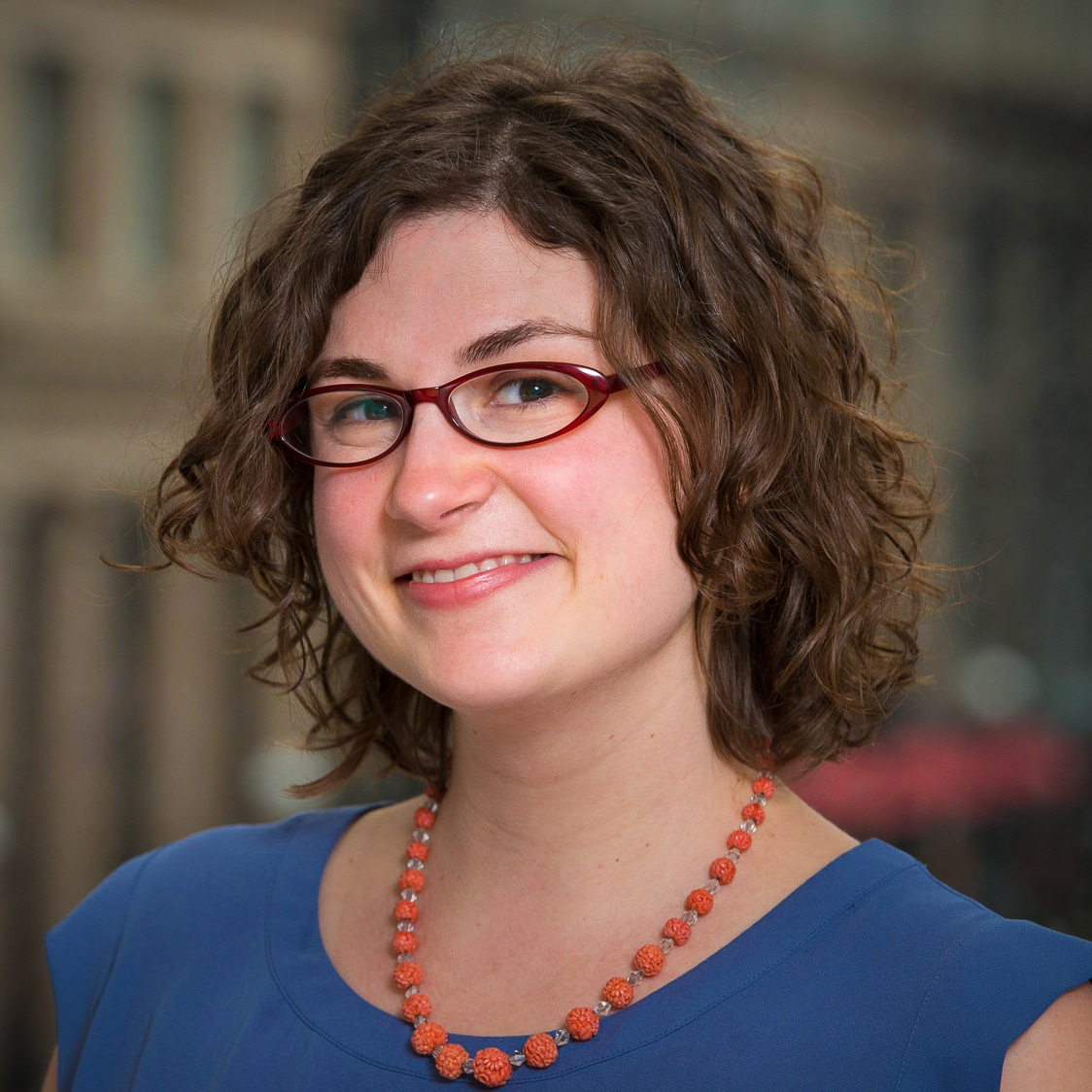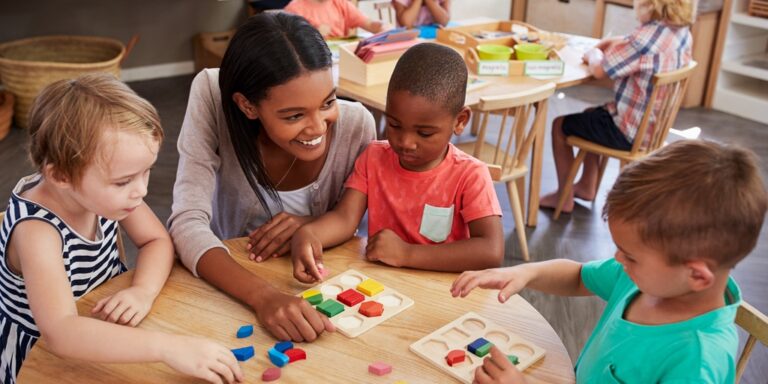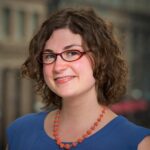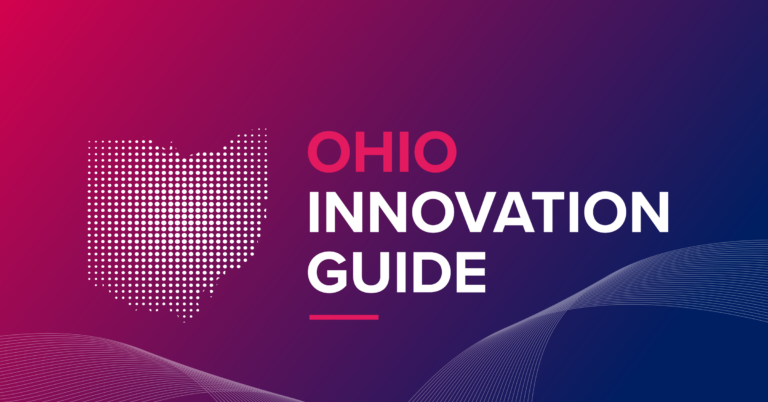When she became superintendent of Marysville Exempted Village School District in 2013, one of Diane Mankins’ first acts was to hold more than 20 community meetings that were open to parents, educators, community leaders and stakeholders. She had two questions for attendees: What are you most proud of in our schools? And if you could wave a magic wand and change one thing, what would it be?
“Everything we’ve done in the district since that time has been the result of those conversations,” says Mankins, who found the positive feedback as informative as the areas community members and school leaders identified for improvement. While many shared their impressions of a safe, purposeful school with good academic performance, there was also a desire to foster stronger relationships with local businesses, to address a workforce gap and to look more closely at what the district could do for every student, rather than just “all” students.
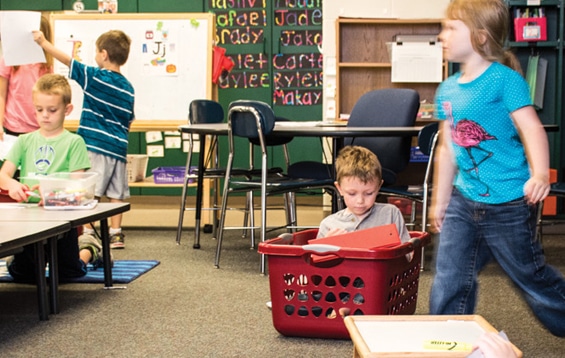
“There was no vision set for the district,” Mankins explains. “There was this sense that we had good teachers, good kids, that everybody was working really hard, but our arrows were all pointing in different directions.”
While the feedback from the community meetings included accolades for the resources the district allocated for students with special needs and for gifted programs, there was a consensus that there wasn’t much being done for the majority of students. But according to Mankins, “every student is special,” and she wanted their district’s vision, and their practices at the school and classroom level, to reflect that.
Following the community forums, Mankins convened a design team, which included individuals from the district and from within the community, to begin crafting what she saw as a much-needed vision for the future of Marysville schools: meeting the needs of every student through personalized learning.
The district applied for and received a $13 million dollar Straight A grant from the state of Ohio, which they used in part to design and open an early college high school in partnership with Columbus State Community College. KnowledgeWorks coaches collaborated with Marysville teachers and administrators to promote a strategic vision for the district, including supporting a STEM-focused, mastery-based learning approach at the early college, and the recent shift to a competency-based model for the entire district.
While early college addressed the immediate community concerns around workforce readiness and highly-skilled positions that were going unfilled in local industry, personalized learning ensured that every child was given the opportunity to thrive. By utilizing a personalized, competency-based approach across the district, students of all ages are developing the essential habits of mind necessary for success in high school, college and career:
- Growth mindset
- Time management
- Self-control
- Taking the initiative and learning to ask for help
While the traditional classroom is focused on teacher accountability, the competency-based classroom gives the student ownership of their learning, allowing them to make meaningful connections between what they’re learning and their interests. The teacher becomes a strong partner in the learning experience, and the student has greater agency and investment in their education.
“One of the exciting things we’re seeing in Marysville is a shift in teacher roles. They’re moving away from owning everything that happens in the classroom to opening up to more student voice and choice,” says Robin Kanaan, KnowledgeWorks’ Director of Teaching and Learning, who facilitated the design team. Kanaan cites how students as young as five or six are given the opportunity to decide on standard operating procedures with their teachers, to choose where they sit, how they want to work, and learning how and when to ask for help from their teachers and peers. “Students have high levels of engagement around what they’re learning, whether they’re five years old or 15 years old.”
The grassroots enthusiasm for personalized learning at Marysville Early College High School and the pilot school, Navin Elementary, is contagious. What Mankins hoped to be a systemic initiative is well on its way, with all nine schools in the district moving toward learner-centered practices beginning in 2016.
Partnering for success
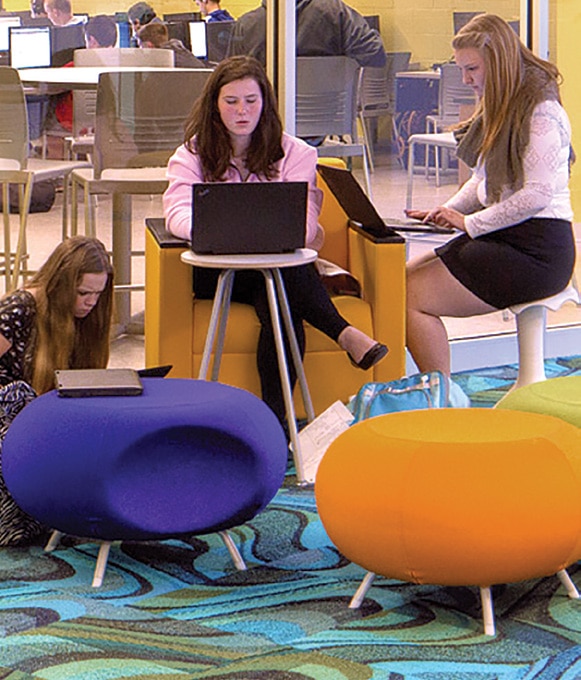
“Prior to opening the early college, when I thought about community partnerships I thought if the local lumberyard could build me a picnic table, that was a partnership,” says Kathy McKinnis, who has been with the district for eleven years and serves as the principal of Marysville Early College High School. “But what I’ve learned, and what I truly believe, is that the partnerships have to be beneficial for the school and the partner.”
Incorporating community voice into the visioning process was just the beginning for Marysville. Community participation and leadership has been critical in the execution of their vision for personalized learning, as well. With the design of the STEM-focused early college high school, Mankins again broadened the conversation beyond the school administration. Design team meetings involved staff from the school’s partners, which included local manufacturer Honda and Columbus State Community College, so the school’s curriculum would reflect real-world employer needs.
It was critical for these community partners to be involved from the beginning to meet the economic needs of the community. Concerns were raised around retirement age, workforce development needs, and ensuring that Marysville graduates had a reason – and the desire – to stay and contribute to the community.
“We talked with our local chamber of commerce, and it became clear that we had their future workforce sitting in our buildings,” says Mankins. “So the conversation then became, how can we help? How can we keep kids local?”
The STEM focus of the early college was intentional, providing the opportunity for local students interested in advanced manufacturing, information technology, and health care to acquire credentials and college credit while still in high school. Together with Columbus State Community College and Ohio High Point Career Center, Honda and the Marysville School District developed curriculum, decided on and secured the necessary equipment for a manufacturing learning pathway, and welcomed the first group of freshman in the fall of 2014.
Every partner plays a critical role:
- Columbus State Community College provides the college credit
- Ohio High Point Career Center works with high school teachers to deliver instruction
- Honda technicians and engineers are creating opportunities for the students to learn about manufacturing careers through tours and knowledge sharing
Students choose a learning pathway at the early college and have the supports and freedom they need to excel.
“In a traditional high school, students don’t have the opportunities that we have here – the opportunity to grow before college, before work,” says Jake Dickman, a junior at the early college high school. “Most students don’t get hands-on experience, but I do.”
Scot McLemore, Manager of Talent Acquisition and Deployment at Honda North America, has been involved with the partnership since the beginning, explains that by working together, they’re able to achieve more and communicate more effectively the value of education than they could apart. Honda had already been involved with a work study program with Columbus State Community College, and the creation of the early college provided an opportunity to introduce local students to the exciting opportunities available with the manufacturer even earlier.
“We had to learn how things worked in each of our worlds,” says McLemore. “Too many times from an industry perspective, we’ll make assumptions about what’s not working at the high school, but creating a forum to communicate and being willing to listen means everyone learns about what’s working, what’s not, and what we can do to better support student learning.”
McLemore hopes to engage even more with the early college in the immediate future, expanding the work study program that Honda currently has with Columbus State Community College to the early college, offering internship opportunities, or simply more tours and speaking engagements from Honda professionals.
“I’ve been with Honda for 27 years and the opportunities are limitless,” McLemore says. “These careers are in their backyard. We put a lot of effort into finding qualified candidates – and now we have a pipeline of talent right out of Marysville.”
Best practices are common practices in Marysville
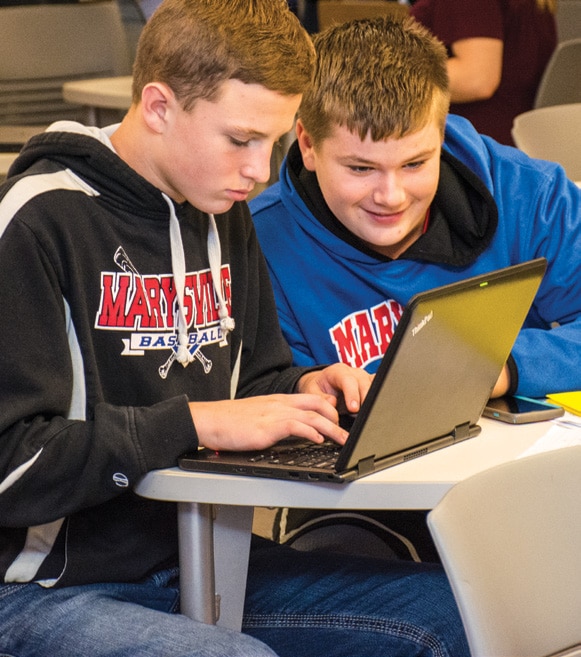
Incorporating student voice and encouraging student agency at all grade levels are essential practices in support of Marysville’s vision, and both students and teachers stand to benefit tremendously from this approach.
“We ask students what they need and what they want, what their pathways are, their challenges,” says McKinnis. She cites the school’s advisory program, called Nucleus, which matches each student up to an advisor for the four years they’ll be at the early college, as a critical support for students and teachers to feel heard, connected, and empowered. Students often work collaboratively in open spaces, and the teachers, too, share an open office space that allows for greater communication across disciplines and shared curriculum design. “Our teachers all share kids, as much as they can.”
At Navin Elementary, Principal Lynette Lewis is equally engaged in capturing student voice and promoting a culture of personalized learning.
“For me, personalizing learning is first believing that every child can learn, and that challenges and mistakes are all apart of learning,” says Lewis, who has been with Navin for eight years. “We need to teach students that by facing challenges – and failing sometimes, and then trying again – that we are actually able to grow our brains and our ability to master a lot of different things.”
Among the methods for elevating student ownership in the classroom that Lewis’ teachers have embraced are flexible seating – providing students the option to sit on the floor or at low tables, in laundry baskets or on wiggle seats – empowering learners through voice and choice and, rather than a teacher deciding the classroom rules, crafting standard operating procedures as a group. Students as young as kindergarten are able to articulate as a class, for example, what they believe constitutes appropriate behavior for getting ready for the day, and there are visual cues throughout the classroom, and eager fellow student helpers, ready to prompt the students who may need the extra support.
One teacher, Hillary Weiser, who has been a kindergarten teacher with the district for 18 years, has found the move to personalized learning empowering not only for her students, but for herself.
“I’ve let the kids take charge of their learning. They know what they need to learn, and it’s up to them how they get there. It’s their choice,” says Weiser, who notes that she rarely experiences discipline issues in her classroom since implementing personalized learning, and attributes this to the sense of ownership and responsibility her students feel to their class. “This room is theirs.”
Students of all ages in Marysville take an active role in determining the standard operating procedures in their classrooms, and in holding each other accountable. Where students in the early college high school frequently work independently or in groups in the many open spaces provided for their use outside of their classrooms, so, too, do learners as young as five or six elect to work on the floor, grouped at low tables or curled up in camp chairs. Freshmen, sophomores, juniors and seniors in high school work with their teachers and their peers to craft methods of demonstrating mastery of specific topics, whether it’s creating a video, designing a piece of software, or writing a research paper.
“Before this school, it was read this chapter, write this thing,” says Robert Moots, a junior at Marysville Early College High School. “The teacher would’ve basically handed you the answer. But here I’m learning to find my own answers and fix my own problems.”
Kanaan stresses that approaching teaching and learning this way encourages students not only to be problem solvers, but “problem finders.”
“Students in Marysville aren’t just passive recipients of knowledge. They choose and design learning experiences with their teachers, and how to show evidence of what they’re learning,” Kanaan says.
Kanaan leads regular, monthly professional development sessions with Marysville teachers, administrators and coaches, providing them the opportunity to strengthen and reflect upon their approaches. Their activities mirror those they co-create with students. It’s common practice for students to be actively engaged in problemsolving, design challenges, project-based learning, to crowd-source their ideas or to participate in blended learning. The learner-centered focus of personalized learning enriches these learning experiences, providing authentic engagement for teacher and student alike. “With this model, we’re challenging everyone to think about what it really looks like when students are in the driver’s seat.”
Serving every student
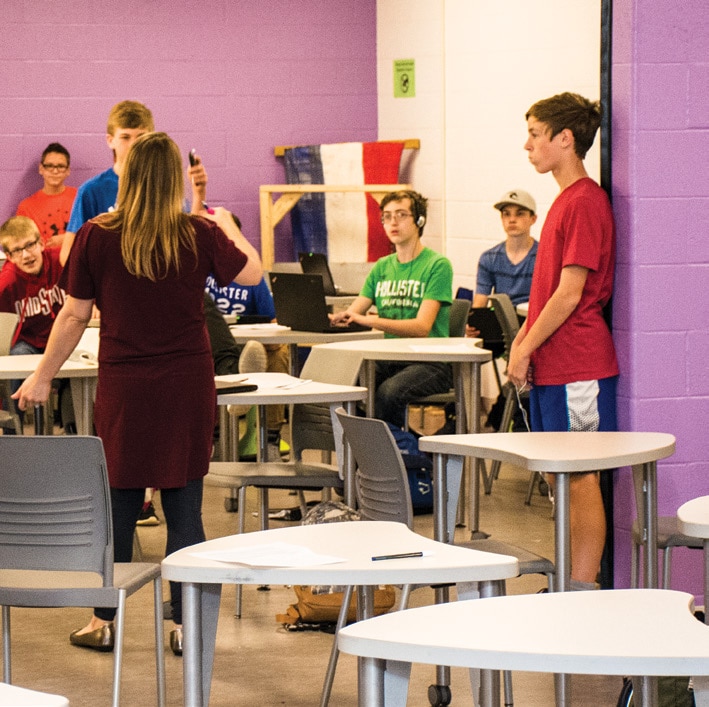
Throughout the district, there are five habits of mind that are demonstrated by all, from the youngest learners to the most seasoned educators: flexibility, out of the box thinking, resiliency, collaboration and communication, and self-sufficiency. Students as young as third grade can explain how they apply growth mindset in the classroom – and beyond – and high school students have time each month to pursue passion projects, like a group of sophomores at the early college high school fundraising for an elementary school in Haiti, or a student-led positive peer mentoring program. Mankins remarks on a recent conversation with one of her teachers, whose son attends one of Marysville’s five elementary schools.
“He was hurt during a basketball game over the weekend, but he fought through it,” Mankins explains. “Afterward he told her, ‘I really showed a lot of perseverance.’ He was so proud.”
Students and teachers alike are given the space to be creative, to take risks, make mistakes, and learn from them. Mankins insists that the idea of “not yet” is a powerful one in her schools, where not getting something quite right the first time doesn’t mean you won’t get it the second, or third, or fourth time. The district is very early in their implementation of competency-based education, but they’re driven by a clear, collective vision of serving every student well. It’s not a top-down approach: just as KnowledgeWorks coaches meet teachers and administrators where they are, so, too, do schools and teachers craft their own best practices around personalized learning.
“My vision for the future of Marysville is that we create learning environments for teachers and students that allow them to progress at their own pace and comfort level,” says Mankins, who stressed the importance of community partnerships with organizations like the YMCA, which allow for students to demonstrate what they’re learning beyond the classroom, and the early college’s partnership with Honda, which is working to develop not only the capabilities of Marysville students, but strengthen the community. “Walls don’t define learning. It’s the community that defines the learning.”
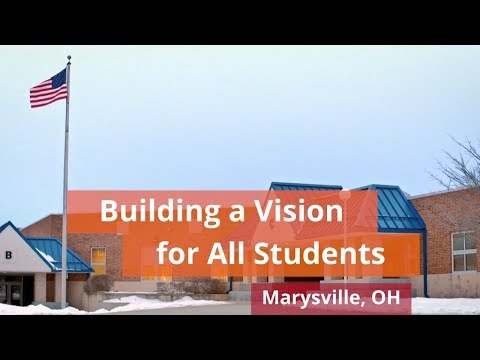
Ready to strengthen your vision to support all students?
- Secure commitment – not ‘buy-in’ – from the community. Invite local higher education institutions, local businesses and government entities into the visioning and decision-making process. Once everyone has a better understanding of what is currently working, what isn’t, and what can be changed to better serve all students, it’s easier to secure community-wide commitment to each child’s success.
- Determine expectations and outcomes. What does student success look like for your community? Parents, educators, civic leaders, community partners, neighbors and students should be a part of determining what an ideal graduate looks like – and work backwards to map the necessary skills and knowledge students need to reach that end goal.
- Reimagine classroom practices. Because most traditional classrooms are one-size-fits-all and designed around seat time, it’s critical to empower teachers to adapt their curriculum based on each student and what they need to succeed. Teachers and students must have the space to take risks and try again, to innovate, collaborate and lead.
- Empower students to own their learning. For over a century, the education system has trained students to be passengers in the learning process rather than drivers. Providing students with voice and choice, empowering them to take ownership of their learning and make meaningful connections between what they’re learning and their interests encourages them to become advocates for their own work.
